|
INVITED CONTRIBUTOR
Working Together in One Space from Many Places
- Written by Susan Stewart, Guided Meetings

I am always delighted to watch how, when using the ToP methods, a wide variety of disparate ideas are shared, refined, categorized and agreed upon, and lead to action. The structure of the methods makes this process seem almost magical. But can that magic happen online? Yes! It can.
The ToP methods, by name and by process are social and participatory. The facilitator builds the structure of the participatory process and facilitative environment and then invites the participants to engage with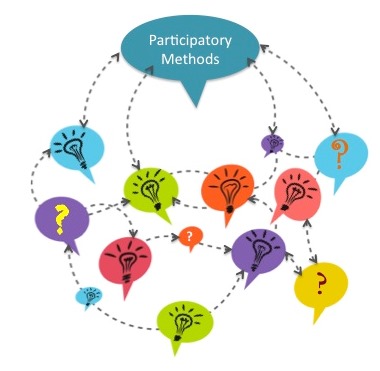 each other and the facilitator. You can see the idea and information flow of participatory methods in the graphic to the right. Attending to the social and participatory nature of ToP methods is no less important when facilitating online…and perhaps it is even more crucial in the virtual environment that is still foreign to many participants. each other and the facilitator. You can see the idea and information flow of participatory methods in the graphic to the right. Attending to the social and participatory nature of ToP methods is no less important when facilitating online…and perhaps it is even more crucial in the virtual environment that is still foreign to many participants.
The last two years my primary work has been online…designing webinars. I am always pushing the participatory edge of online learning experiences, often drawing upon ToP methods to build relevance and interest with the participants. Over time I have expanded into supporting others in the design and facilitation of participatory online meetings…including some Consensus Workshops that extended over time, geography, and corporate hierarchies. Drawing upon these experiences I have collected and developed some tips, hints, rules of thumb that inform my work online. In general, these strategies address the issues of participant attention and engagement, and maximizing the power of the platform through imagery. I offer these to you in the spirit of creativity and collegiality, please contribute your ideas for enhancing online conversations and collaboration in the ToP Network open forum on virtual facilitation. (How to access the Open Forum)
Get ‘Em Interested Early and Often
I believe it is incumbent upon the online facilitator to draw participants into the facilitative environment, get them engaged with one another and the topic or issue at hand, and support them in their active participation. But how does this happen?

Gaining Attention: Don’t Be Boring!
Dr. John Medina, a neuroscientist, has distilled some of the most complex and interesting brain research into some helpful “rules”. Rule #4 is that we don’t pay attention to boring things. The online facilitator is competing against many other activities that are compelling to the participants: email, Facebook, lunch, colleagues, the dog, children, etc. Therefore, the facilitator has to work even harder online to create an environment and a process that is enticing to the participant.

Research shows that the first fifteen minutes of a webinar is when participants are most attentive. After fifteen minutes, their attention wanes…unless you do something about it. This is relevant for facilitators using group processes, especially during the gathering and contexting time. The online facilitator must gain the participants’ attention early and maintain their attention in effective and relevant ways.
Maintaining Attention: Beg and Be Relevant
But it’s not only the beginning of the webinar or online meeting that is critical for gaining and maintaining participants attention…the 10 minute rule that is described by John Medina indicates that every 10 minutes you need to re-gain participant’s attention. And he’s talking about face-to-face situations! Online participants have even more distractions begging them to turn away from the conversation.
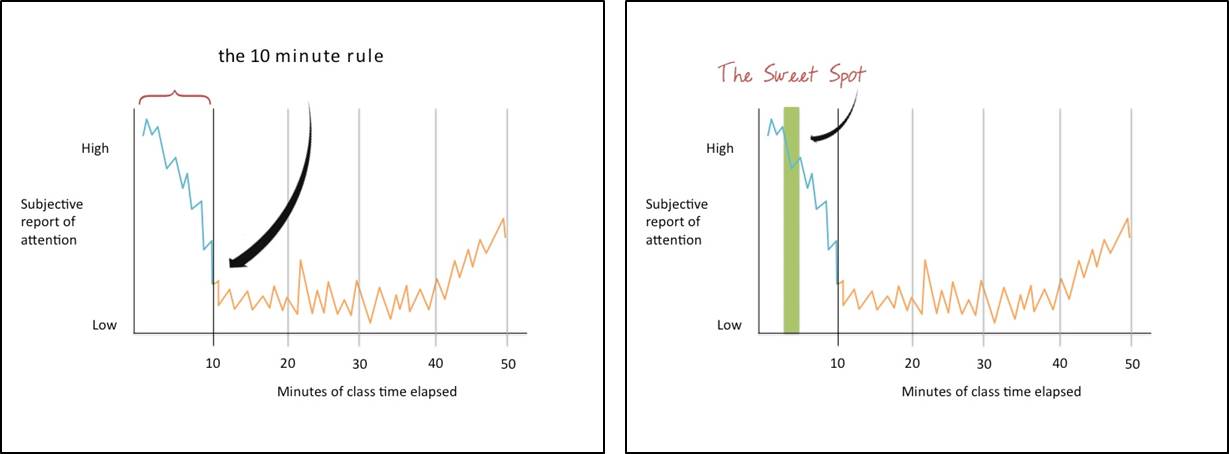
The impact of this 10 minute rule is rather astounding. Dr. Medina puts it this way…if keeping someone’s attention in a lecture was a business, it would have an 80% failure rate. There is a difference, he’s talking about a lecture, but let’s put all of these pieces together:
- People are hard-wired to seek out interesting and novel things…we do not pay attention to boring things.
- The online facilitator has only 5-10 minutes to “hook” the participants attention and get them engaged. If that does not happen, 80% of the participants tune out.
Often, we spend a lot of upfront time telling people stuff…welcoming folks, setting the context, giving instructions, etc. rather than engaging participants within the first 5-10 minutes. If this is the case, then the question we must ask ourselves about online facilitation is, are we willing to risk having an 80% failure rate? I certainly hope not, either we will lose clients or we will lose our jobs!

One way that we can guard against such a failure rate – throughout our time online – is to interject something that is emotionally relevant…tell a relevant story, explore relevant data, show a relevant video, do a relevant activity…every 10 minutes. Fortunately, the ToP methods are built on relevancy for the participants. Also, the methods are designed to work within the sweet spot of engagement...webinar best practices, which are applicable in other live online experiences, indicate that we should be doing something to beg the participants’ attention every 3-5 minutes.
Supporting Attention through Participation: Engage and Interact
In face-to-face situations facilitators can watch body language to see if participants are tuned into what is going on…even if they are quiet. Online those cues do not exist. So what is a facilitator to do?! The online facilitator must actively and persistently beg for the participants’ attention and engagement throughout the process. Fortunately there are many tools built into online platforms that support participants’ engagement…polls, chat, audio, whiteboards, webcams, electronic “stickies”, etc. Almost anything that you would do in a face-to-face facilitation you can do…with modifications in the online environment. This is one of those points where curiosity, creativity, and the openness to ask questions and share resources come into play to adapt our thinking for online facilitation.
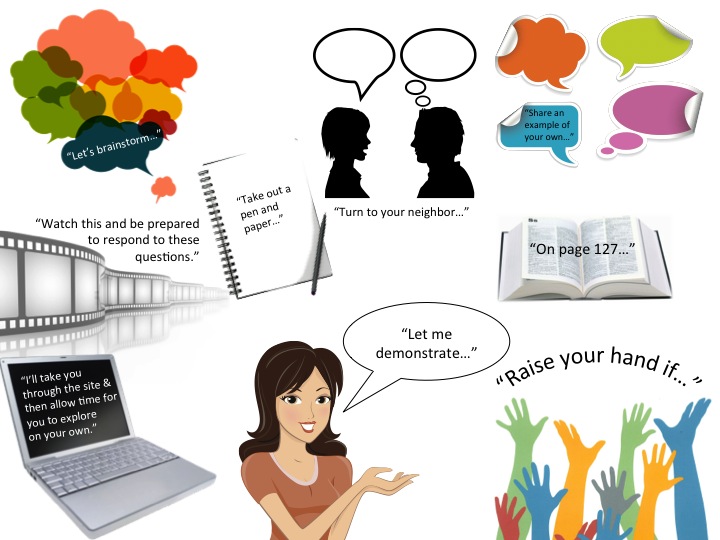 I think of participation as being made up of two major categories of activities: engagement and interaction. Engagements are those times when you ask the participants to do something, but there is not a give and take between people, like jotting something down on a piece of paper, finding a page in a book, exploring a website, or watching a video. Interactions are activities that foster some level of give and take between the participants or between participants and the facilitator. Interactions include answering a question with hand-raising or a yes-no poll, using chat to share an experience or idea or ask a question…and in more complex facilitations interactions can include small group conversations, creating action plans, and so on. I think of participation as being made up of two major categories of activities: engagement and interaction. Engagements are those times when you ask the participants to do something, but there is not a give and take between people, like jotting something down on a piece of paper, finding a page in a book, exploring a website, or watching a video. Interactions are activities that foster some level of give and take between the participants or between participants and the facilitator. Interactions include answering a question with hand-raising or a yes-no poll, using chat to share an experience or idea or ask a question…and in more complex facilitations interactions can include small group conversations, creating action plans, and so on.
TIP: plan for at least twice as much time in both the design and the actual facilitation online as you would for a face-to-face situation.
Interactions take substantially longer online than in face-to-face settings. It takes participants longer to respond online. First they must process the request for interaction, then they need to decide what their response will be, and then they have to locate and use the tool to share their response. In the online environment, I have noticed that participants do more self-filtering and self-editing. Many participants are concerned because their words are written and often associated with their name in the online environment. Also, they pay more attention to spelling and grammar. All of these filters increase the time it takes online participants to respond. In addition, not only must the facilitator wait for participants to respond, they must be explicit in acknowledging the contributions of the online participants. If they do not acknowledge the participants’ responses, then the participants feel as if their contributions fell into a void…making it less likely that they will contribute in the future.

Interactions and Response Times in Online Facilitation (The image on the left is a visualized depiction of the chart on the right.)
The absolute hardest part of waiting for responses is being quiet for the minimum amount of time it takes the participants to respond. And yet, this is critical! If you rush it, you will move on before the participants have had a chance to contribute…and once again you send the message that their contributions are not important. To avoid rushing participants, I have created a set of guidelines (see above) to help me time out several types of interactions.
TIP: Set a timer for the minimum response time and do not speak until the timer goes off.
It also helps me to remember that their experience as participants is different than mine as a facilitator. I am on pins and needles counting each and every second…waiting, for what seems to be an eternity, to see their responses. They, on the other hand, are thinking and writing or unmuting their phones or using some other tool. They are busy and not counting the seconds until I speak again
Supporting Participation: Teach Etiquette.
 In order to foster the participants’ engagement in online environments, the facilitator must also guide the participants a little more explicitly. Online etiquette must be taught. In order to foster the participants’ engagement in online environments, the facilitator must also guide the participants a little more explicitly. Online etiquette must be taught.
TIP: Provide written instructions for activities.
There is a tendency for participants to “check out” online when minor distractions come into their physical environment. Therefore it is critical that the instructions and directions that are usually stated are always readily available to the participants in written form.
Visualize It!
 Since the online environment is such a visually dependent medium adding graphical elements can go a long way to gain and maintain participants’ attention and support, as well as guide participants’ engagement and interaction. This brings us to John Medina’s Brain Rule number 10…vision trumps all other senses. Because images we see are more deeply etched in our minds than text we read…and because we don’t pay attention to boring things…it’s important that we do what I call visualizing the online environment. Visualizing includes ways of providing instructions with images rather than (just) text and creating a backdrop for contributions from participants, among other things. See below for an example of the wave activity that was completed on the Blackboard Collaborate platform. Since the online environment is such a visually dependent medium adding graphical elements can go a long way to gain and maintain participants’ attention and support, as well as guide participants’ engagement and interaction. This brings us to John Medina’s Brain Rule number 10…vision trumps all other senses. Because images we see are more deeply etched in our minds than text we read…and because we don’t pay attention to boring things…it’s important that we do what I call visualizing the online environment. Visualizing includes ways of providing instructions with images rather than (just) text and creating a backdrop for contributions from participants, among other things. See below for an example of the wave activity that was completed on the Blackboard Collaborate platform.
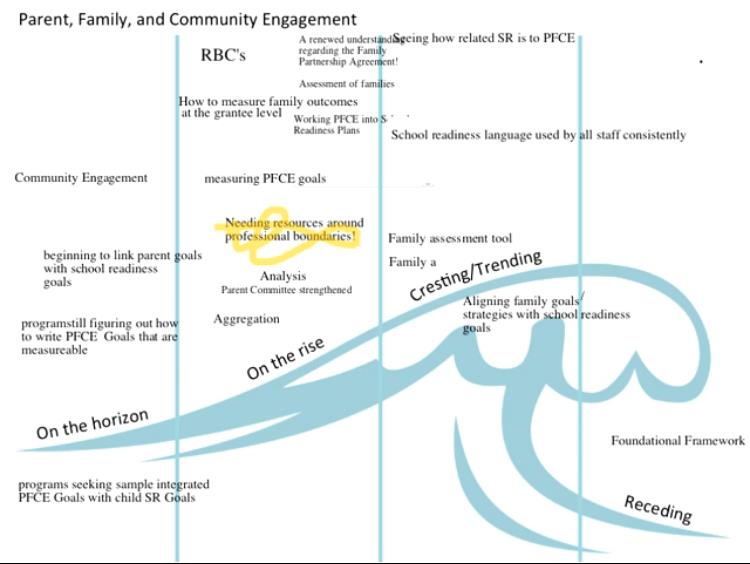
I use PowerPoint as my canvas for visualizing, but I eschew the templates and the master slides. Instead, I always begin with a blank white slide. The blank slide reduces the temptation to rely on text and allows me to build a story or lead participants through a thought process with limited text. (See references/resources at the end for a list of free image websites.)
TIP: Did you know? It is nearly impossible for someone to use two language channels at the same time. They can either read language or hear language…but they can’t really read and listen at the same time…at least not with much depth or accuracy.
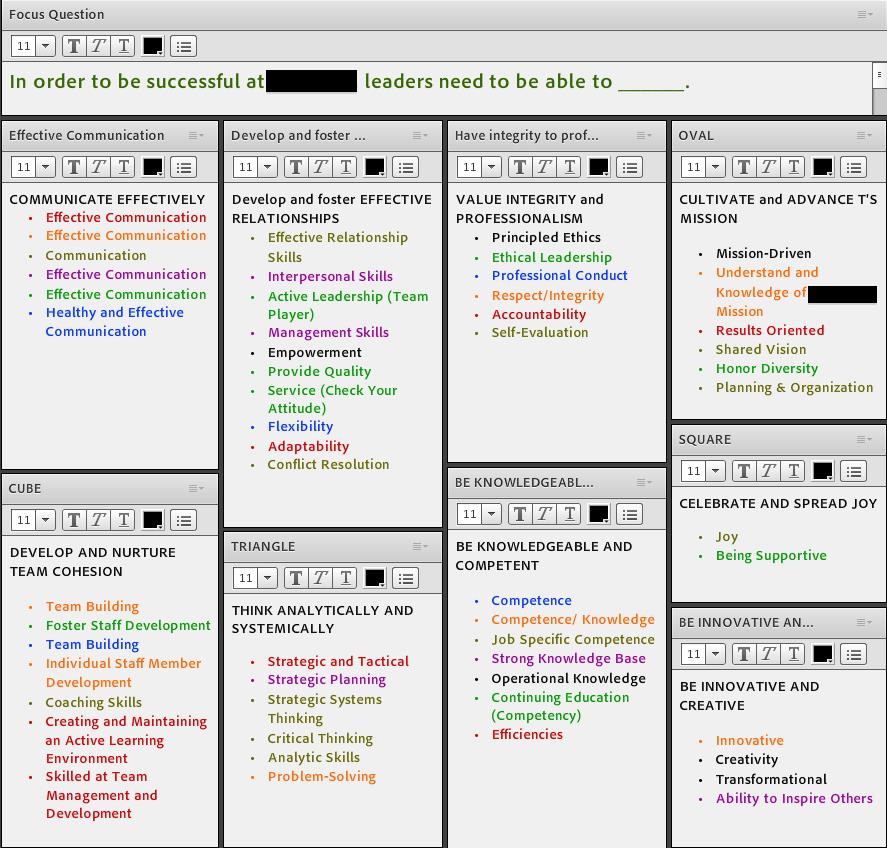 Color-coding is another way to visualize content. In the image to the left you see how we were able to track data developed in small groups as we made clumps across all of the data back in the main room. (Each small group in the breakout rooms was assigned a color…all of the purple ideas were generated by one group while all of the blue ideas were generated by another group, and so on.) This is also provides a support to participants when there is a lot of text in the online environment. The colors make it easier for participants to distinguish where one thought stops and starts. Also, when clumping, it’s easier for the producer to located the idea if a color is provided along with directional language. For example, “move the blue bullet in the lower left box to the box in the upper right corner.” Color-coding is another way to visualize content. In the image to the left you see how we were able to track data developed in small groups as we made clumps across all of the data back in the main room. (Each small group in the breakout rooms was assigned a color…all of the purple ideas were generated by one group while all of the blue ideas were generated by another group, and so on.) This is also provides a support to participants when there is a lot of text in the online environment. The colors make it easier for participants to distinguish where one thought stops and starts. Also, when clumping, it’s easier for the producer to located the idea if a color is provided along with directional language. For example, “move the blue bullet in the lower left box to the box in the upper right corner.”
TIP: Use directional language to help participants locate the visual elements to which you want them to attend.
A Final Tip and a Confession
Now that I am nearing the end of sharing my learnings with you, I think I need to come clean. I have moved from being a skeptic about the utility of virtual environments for collaborative efforts with dispersed participants to someone who has witnessed success and believes in the potential power of the medium.
Throughout this work I have been struck by how participants from all levels of an organization and from different locations can participate using the online environment. For example, within one organization the virtual environments enabled participation by CEO’s on one end of the spectrum to janitors on the other end of the spectrum. Nearly all of them (from the executives to the service staff) expressed appreciation that they were able to contribute to matters that are important to them. Barriers caused by time and distance, were significantly reduced by using the virtual environment.
In the process, I have come to appreciate that preparing for such activities differs from facilitation in face-to-face environments in that it requires more time (both in planning and during the actual facilitation) and new ways of interacting online. I have found that facilitating using online platforms requires a lot of creativity and flexible thinking so that the tools available in any given platform can be maximized and bent to my needs.
TIP: Work with a producer who can manage the technical aspects of the work while you focus on the participants and their contributions.
Online facilitation is not for every person or for every situation, but if you are curious about it...jump in! There is no one right way to learn but learning by doing is essential!
Resources
- Moving to the Virtual Classroom (2011) Cindy Huggett
- Seven Deadly Sins of Online Training Presentations (2011) Roger Courville
- Webinars: Designing Effective Learning Experiences (2011) Beth Kanter
- Webinars That Work (2011) Pluth and Pike
- ToP Virtual Facilitation Fieldbook (2012) Ester Mae Cox, Sheila LeGeros, and Eunice Shankland
- Webinars with Wow Factor (2010) Pluth
- The Future of eLearning is Social Learning (2009) Jane Hart
- 144 Tips on Synchronous e-Learning: Strategy and Research (2008) The eLearning Guild
- Brain Rules: 12 Principles for Surviving and Thriving at Work, Home, and School (2008) John Medina
- Synchronous Training Planner (2007) Karen Hyder
- Facilitating Online Interaction (2002) Nancy White
- Best Practices for Interactive Webinars (n.d.) Maine Commission for Community Service – E Cole, AmeriCorps*VISTA
- Simple, Effective, Online Training: Online Trainer’s Checklist (n.d.) Huggett & Corbett
- Speaker Tracking Form (n.d.) Karen Hyder
- Webinar Storyboard (n.d.) Karen Hyder
- The Virtual Trainer’s Checklist for Interactive Delivery, Counter-Intuitive Design and Social Interaction (n.d.) Terrence Gargiulo
How to access the Open Forum:
- Members - login, click on Top Community Forum in Quick Links column at right. Scroll down to Open Forum for Members and Colleagues.

- Non members on contact list - login, This landing page provides tips for participating and a click on the forum link takes you right to the Open Forum.
Back to Top
|


 each other and the facilitator. You can see the idea and information flow of participatory methods in the graphic to the right. Attending to the social and participatory nature of ToP methods is no less important when facilitating online…and perhaps it is even more crucial in the virtual environment that is still foreign to many participants.
each other and the facilitator. You can see the idea and information flow of participatory methods in the graphic to the right. Attending to the social and participatory nature of ToP methods is no less important when facilitating online…and perhaps it is even more crucial in the virtual environment that is still foreign to many participants.



 I think of participation as being made up of two major categories of activities: engagement and interaction. Engagements are those times when you ask the participants to do something, but there is not a give and take between people, like jotting something down on a piece of paper, finding a page in a book, exploring a website, or watching a video. Interactions are activities that foster some level of give and take between the participants or between participants and the facilitator. Interactions include answering a question with hand-raising or a yes-no poll, using chat to share an experience or idea or ask a question…and in more complex facilitations interactions can include small group conversations, creating action plans, and so on.
I think of participation as being made up of two major categories of activities: engagement and interaction. Engagements are those times when you ask the participants to do something, but there is not a give and take between people, like jotting something down on a piece of paper, finding a page in a book, exploring a website, or watching a video. Interactions are activities that foster some level of give and take between the participants or between participants and the facilitator. Interactions include answering a question with hand-raising or a yes-no poll, using chat to share an experience or idea or ask a question…and in more complex facilitations interactions can include small group conversations, creating action plans, and so on.
 In order to foster the participants’ engagement in online environments, the facilitator must also guide the participants a little more explicitly. Online etiquette must be taught.
In order to foster the participants’ engagement in online environments, the facilitator must also guide the participants a little more explicitly. Online etiquette must be taught. Since the online environment is such a visually dependent medium adding graphical elements can go a long way to gain and maintain participants’ attention and support, as well as guide participants’ engagement and interaction. This brings us to John Medina’s Brain Rule number 10…vision trumps all other senses. Because images we see are more deeply etched in our minds than text we read…and because we don’t pay attention to boring things…it’s important that we do what I call visualizing the online environment. Visualizing includes ways of providing instructions with images rather than (just) text and creating a backdrop for contributions from participants, among other things. See below for an example of the wave activity that was completed on the Blackboard Collaborate platform.
Since the online environment is such a visually dependent medium adding graphical elements can go a long way to gain and maintain participants’ attention and support, as well as guide participants’ engagement and interaction. This brings us to John Medina’s Brain Rule number 10…vision trumps all other senses. Because images we see are more deeply etched in our minds than text we read…and because we don’t pay attention to boring things…it’s important that we do what I call visualizing the online environment. Visualizing includes ways of providing instructions with images rather than (just) text and creating a backdrop for contributions from participants, among other things. See below for an example of the wave activity that was completed on the Blackboard Collaborate platform.
 Color-coding is another way to visualize content. In the image to the left you see how we were able to track data developed in small groups as we made clumps across all of the data back in the main room. (Each small group in the breakout rooms was assigned a color…all of the purple ideas were generated by one group while all of the blue ideas were generated by another group, and so on.) This is also provides a support to participants when there is a lot of text in the online environment. The colors make it easier for participants to distinguish where one thought stops and starts. Also, when clumping, it’s easier for the producer to located the idea if a color is provided along with directional language. For example, “move the blue bullet in the lower left box to the box in the upper right corner.”
Color-coding is another way to visualize content. In the image to the left you see how we were able to track data developed in small groups as we made clumps across all of the data back in the main room. (Each small group in the breakout rooms was assigned a color…all of the purple ideas were generated by one group while all of the blue ideas were generated by another group, and so on.) This is also provides a support to participants when there is a lot of text in the online environment. The colors make it easier for participants to distinguish where one thought stops and starts. Also, when clumping, it’s easier for the producer to located the idea if a color is provided along with directional language. For example, “move the blue bullet in the lower left box to the box in the upper right corner.”